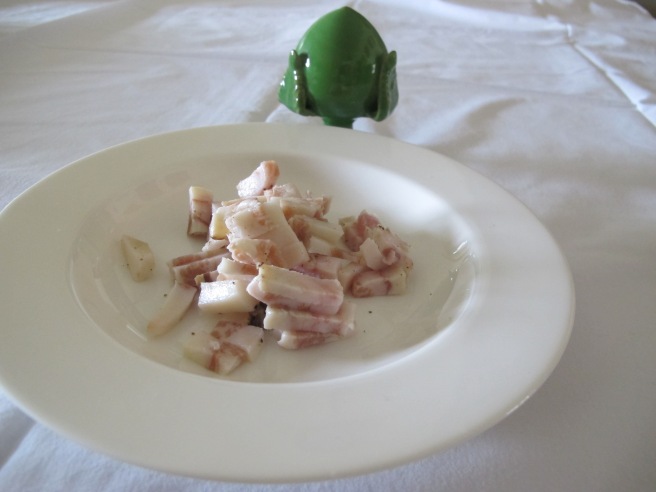The venerable vegetable stew known as Vignarola. I have written about it before, yes I have. I was prompted to do so again (vignarola mania?) because in today’s recipe I went to the added trouble of removing the outer sheath of the broad beans, an excercise in ‘poshifying’ the dish as it were, hence the title.
 Simple ingredients, very grand finale. I don’t know how many of you will go to the trouble of actually making a vignorala. It is not at all difficult but it does take time. I have tried to present the recipe to make it as time-friendly as possible.
Simple ingredients, very grand finale. I don’t know how many of you will go to the trouble of actually making a vignorala. It is not at all difficult but it does take time. I have tried to present the recipe to make it as time-friendly as possible.
Ingredients:
Two artichokes, preferably the Roman kind that are at their prime in this season (Spring).
Fresh peas
Fresh broadbeans /fava beans
Spring onions
Lettuce
Pancetta or guanciale – or neither if you are a vegetarian
Olive oil (evoo), salt and pepper
Fresh mint leaves
Let’s take a look at the ingredients. I have placed them on the same plate so that you can get an idea of the proportions Roughly speaking, one needs the same amount of all the vegetables
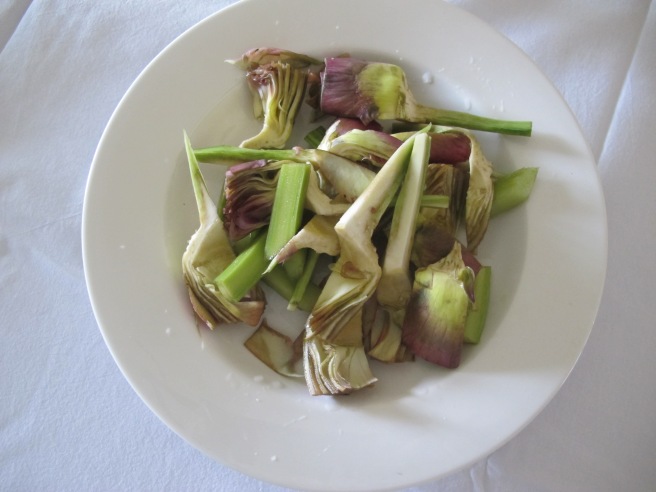 What you see on this plate are two trimmed and sliced artichokes.
What you see on this plate are two trimmed and sliced artichokes.
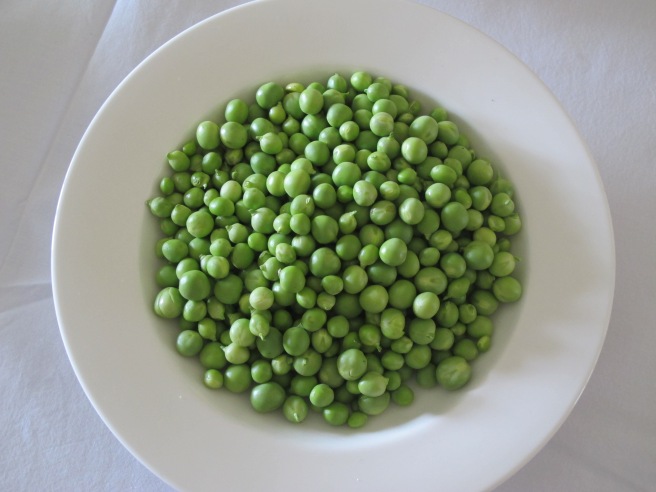 These are fresh peas.
These are fresh peas. Here are the fresh broadbeans / fava beans.
Here are the fresh broadbeans / fava beans.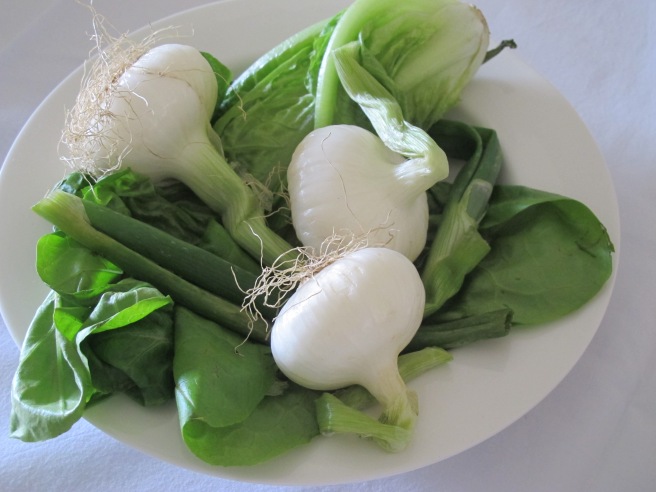 Here are the spring onions and the lettuce.
Here are the spring onions and the lettuce.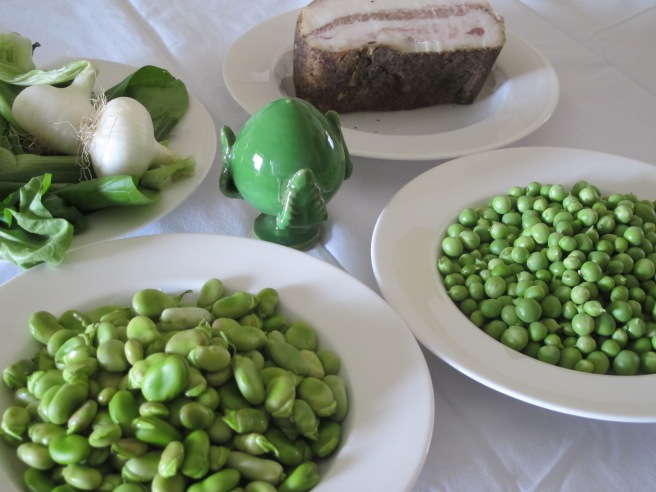 On the far north of this photo is the guanciale, the pork jowl. In the middle of the photo is a ceramic decorative object known as a ‘pumo’. It comes from Puglia and it is symbolic of good luck and the augury of all good things to come. I stuck it in the middle of the plates because I associate the colour green with Spring and with the making of the green vignarola vegetables: artichokes, peas and broadbeans.
On the far north of this photo is the guanciale, the pork jowl. In the middle of the photo is a ceramic decorative object known as a ‘pumo’. It comes from Puglia and it is symbolic of good luck and the augury of all good things to come. I stuck it in the middle of the plates because I associate the colour green with Spring and with the making of the green vignarola vegetables: artichokes, peas and broadbeans.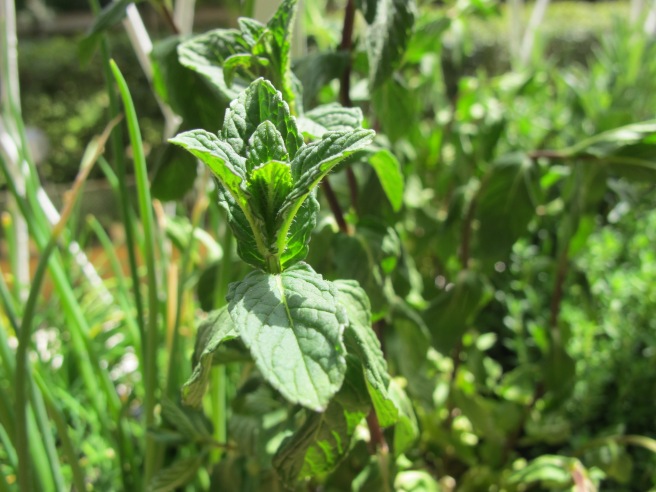 It is traditional to also add mint to the vignarola stew … here is some ordinary mint from a plant on my balcony.
It is traditional to also add mint to the vignarola stew … here is some ordinary mint from a plant on my balcony.
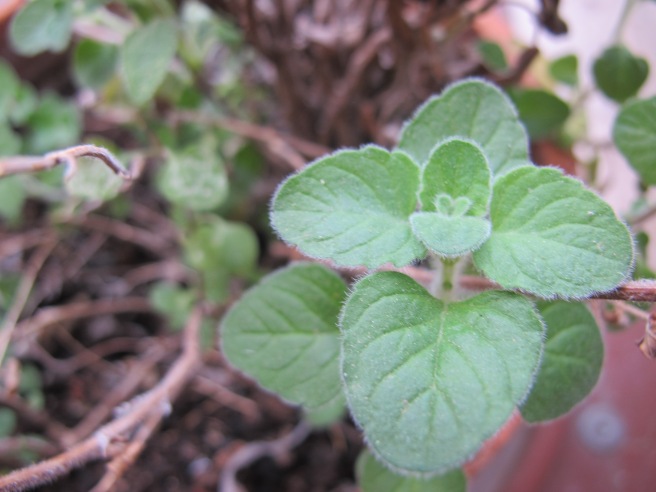 This instead (again on my balcony) is the mint called ‘mentuccia romana’ … and pennyroyal in English. Even my herbs have to be ‘royal’, you see, ha ha ha! Mentuccia romana is the mint that is used to stuff braised artichokes in the recipe called ‘carciofi alla romana’. I decided to use both kinds. And now on with the :
This instead (again on my balcony) is the mint called ‘mentuccia romana’ … and pennyroyal in English. Even my herbs have to be ‘royal’, you see, ha ha ha! Mentuccia romana is the mint that is used to stuff braised artichokes in the recipe called ‘carciofi alla romana’. I decided to use both kinds. And now on with the :
PREPPING
Here is the guanciale thickly sliced into a matchstick shape.
 The roughly chopped spring onions …
The roughly chopped spring onions … Bring a pan of water to the boil and add the broadbeans …
Bring a pan of water to the boil and add the broadbeans …
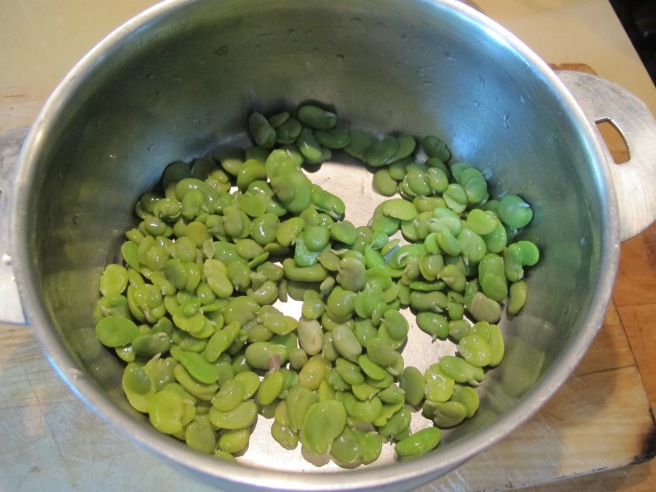 Simmer the broadbeans for about 2 minutes, then drain and place in a bowl of iced or at least very cold water to cool them down. Then arm yourself with a good deal of patience … or better still, find someone else to step in and help you … and get on with the job of removing the skin of the broadbeans. One by one … Oh yes … it takes ages.
Simmer the broadbeans for about 2 minutes, then drain and place in a bowl of iced or at least very cold water to cool them down. Then arm yourself with a good deal of patience … or better still, find someone else to step in and help you … and get on with the job of removing the skin of the broadbeans. One by one … Oh yes … it takes ages.
 Trim the artichokes. This means removing the outer petals of the globe; and then quarter each artichoke, and quarter again : i.e. cut into 8 pieces. Once cut, the artichokes must immediately be placed in a bowl of water to avoid the oxygen in the air turning them black. Every single recipe I have come across calls for lemon juice to be added to the water, and lemony water is what I always used too. But I found out only recently that it actually isn’t necessary at all – the water is quite sufficient. And now that we have everything in place … we can get cracking.
Trim the artichokes. This means removing the outer petals of the globe; and then quarter each artichoke, and quarter again : i.e. cut into 8 pieces. Once cut, the artichokes must immediately be placed in a bowl of water to avoid the oxygen in the air turning them black. Every single recipe I have come across calls for lemon juice to be added to the water, and lemony water is what I always used too. But I found out only recently that it actually isn’t necessary at all – the water is quite sufficient. And now that we have everything in place … we can get cracking.
Step 1: Cooking the peas
 Dribble a generous amount of olive oil into a frying pan. I have a penchant for pepper corns and tinker them into nearly all my recipes. Here, I put six pepper corns into the pan. You may wish to avoid them altogether – you decide.
Dribble a generous amount of olive oil into a frying pan. I have a penchant for pepper corns and tinker them into nearly all my recipes. Here, I put six pepper corns into the pan. You may wish to avoid them altogether – you decide.
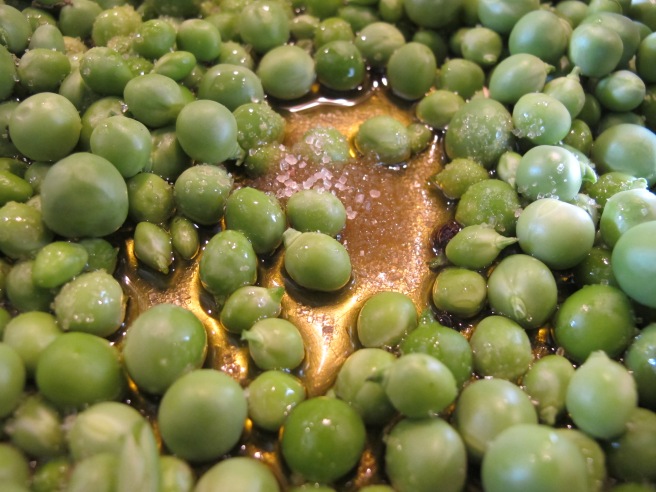 Turn on the heat, and put the peas in the pan. Add one teaspoon of sugar.
Turn on the heat, and put the peas in the pan. Add one teaspoon of sugar. Add one teaspoon of salt over the sugar.
Add one teaspoon of salt over the sugar.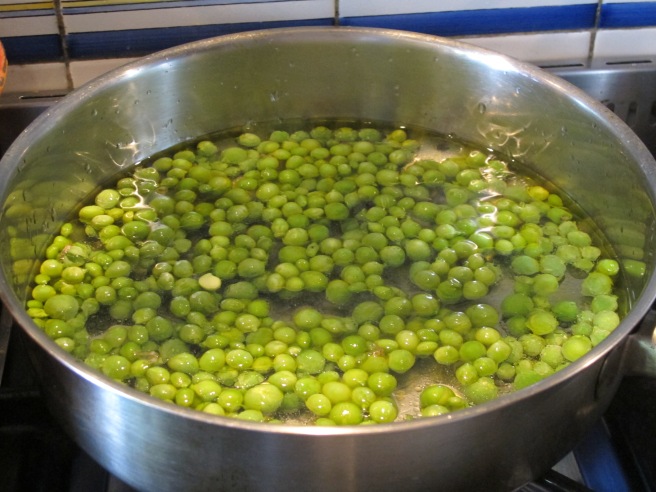 Pour boiling water into the pan. Plenty of it … enough to cover the peas by 2 cm (an inch or so).
Pour boiling water into the pan. Plenty of it … enough to cover the peas by 2 cm (an inch or so).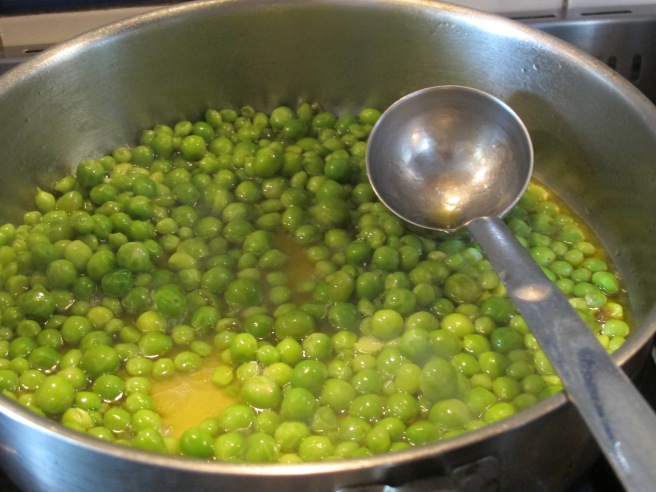 Simmer until the peas are tender. It took the better part of 20 minutes to cook these. Peas done. Turn off heat, set aside.
Simmer until the peas are tender. It took the better part of 20 minutes to cook these. Peas done. Turn off heat, set aside.
Step 2: Cooking the Guanciale
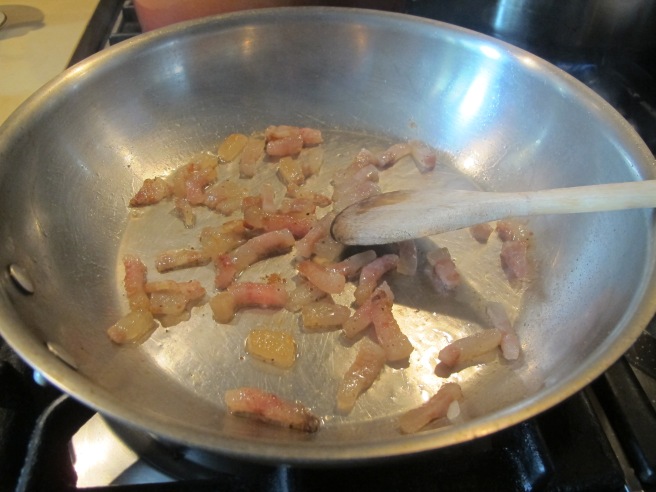 Use another frying pan to render the fat of the guanciale over a medium heat. This takes about 2-3 minutes.
Use another frying pan to render the fat of the guanciale over a medium heat. This takes about 2-3 minutes. Once the guanciale has crispened up a bit, add some olive oil.
Once the guanciale has crispened up a bit, add some olive oil.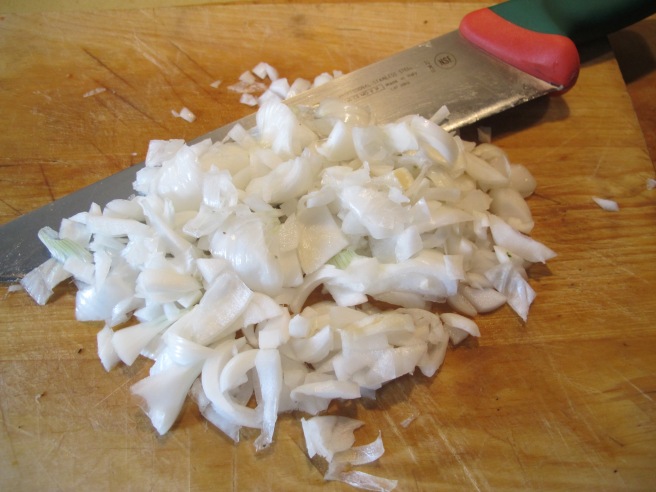
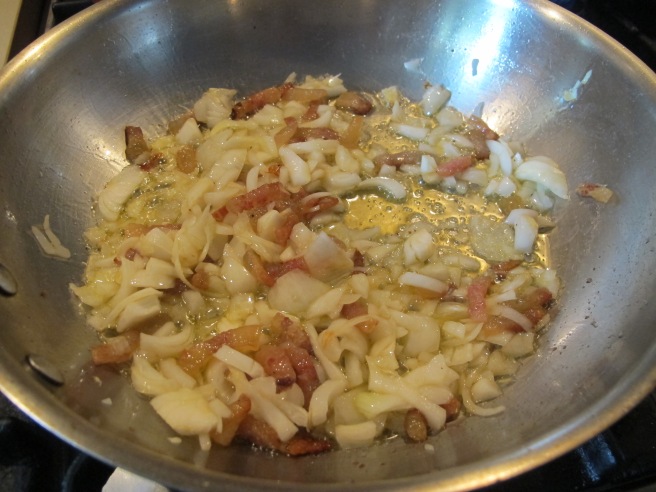 Now add the spring onions. Cook for only a couple of minutes.
Now add the spring onions. Cook for only a couple of minutes.
Step 3: Cooking the Artichokes
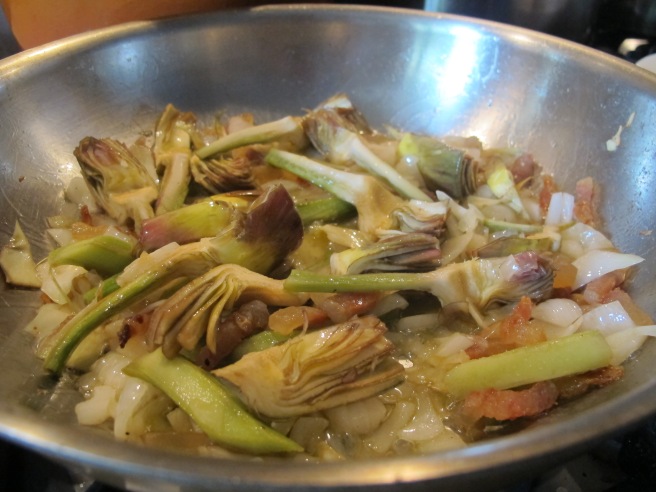 Now add the artichokes. Cook for about 2-3 minutes …
Now add the artichokes. Cook for about 2-3 minutes …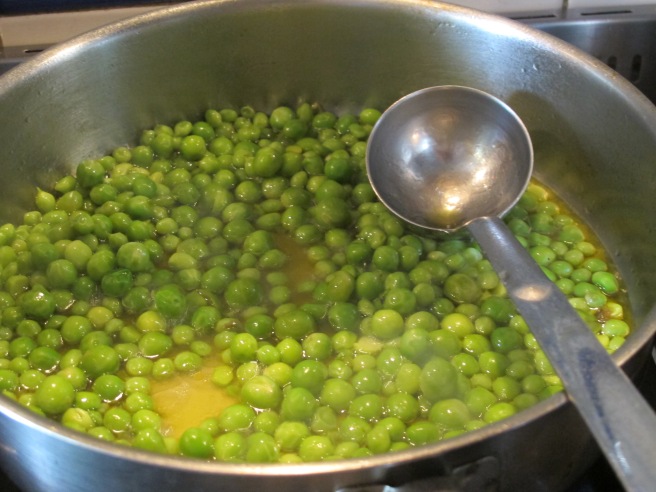 Remember the peas? See how much cooking water there was? a kind of pea soup?
Remember the peas? See how much cooking water there was? a kind of pea soup?
 Pour some of the pea soup using a sieve into the frying pan.
Pour some of the pea soup using a sieve into the frying pan.
 Keep cooking … the artichokes will need this liquid to become tender.
Keep cooking … the artichokes will need this liquid to become tender.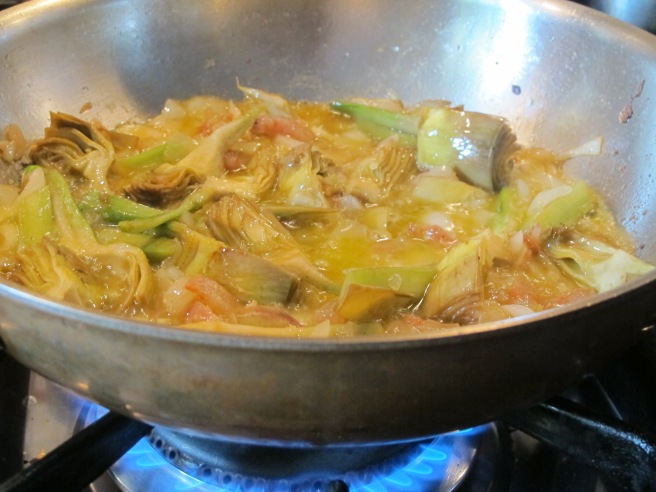 The flame is quite high.
The flame is quite high.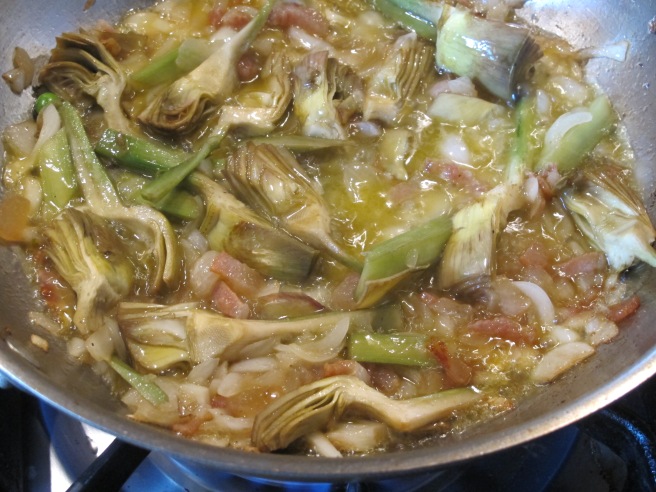 Keep adding the pea soup, as required.
Keep adding the pea soup, as required.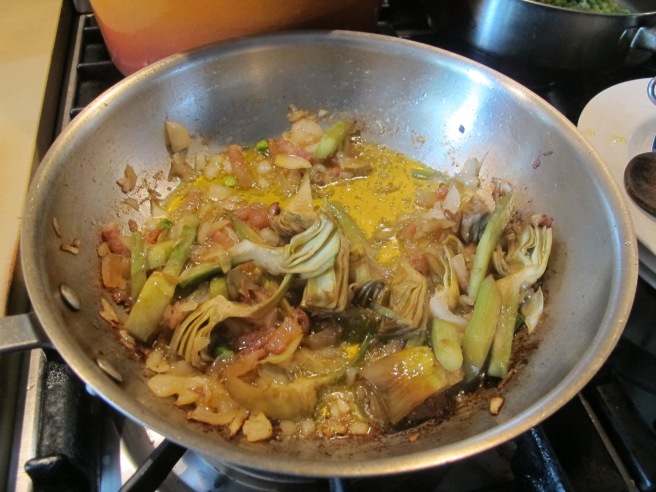 When the artichokes are tender (push a fork through one of them to find out when) … it should take about 10 minutes or so from start to finish …
When the artichokes are tender (push a fork through one of them to find out when) … it should take about 10 minutes or so from start to finish …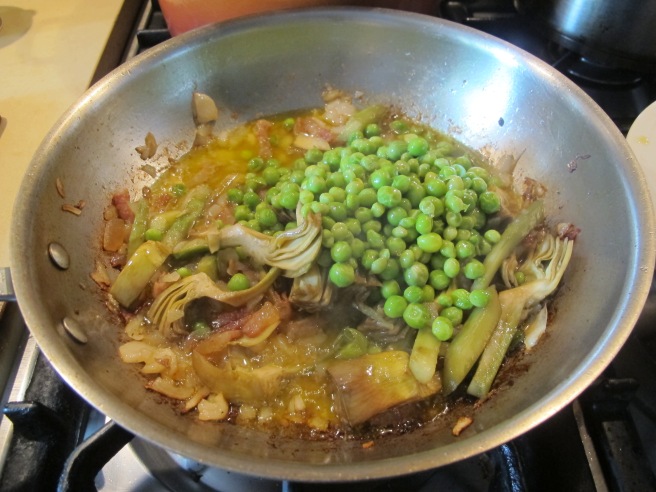 Add the cooked peas. Turn the heat down now.
Add the cooked peas. Turn the heat down now.
Step 4: Wilting the lettuce
 Put the lettuce where the peas had been (please notice I used up all the pea soup) bar a tiny amount.
Put the lettuce where the peas had been (please notice I used up all the pea soup) bar a tiny amount.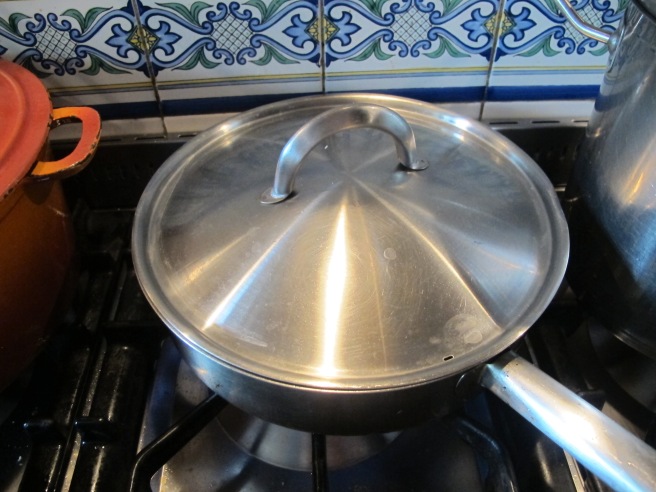 Cover with a lid and cook for about 1 minute.
Cover with a lid and cook for about 1 minute. Remove lid and add them to the big saucepan with the artichokes and peas.
Remove lid and add them to the big saucepan with the artichokes and peas.
Step 5: Bringing all the Pieces Together
 Remember these? Add the broadbeans to the big saucepan and use a wooden spoon to gently combine all the ingredients, cooking them for another couple of minutes.
Remember these? Add the broadbeans to the big saucepan and use a wooden spoon to gently combine all the ingredients, cooking them for another couple of minutes. The two kinds of mint …
The two kinds of mint …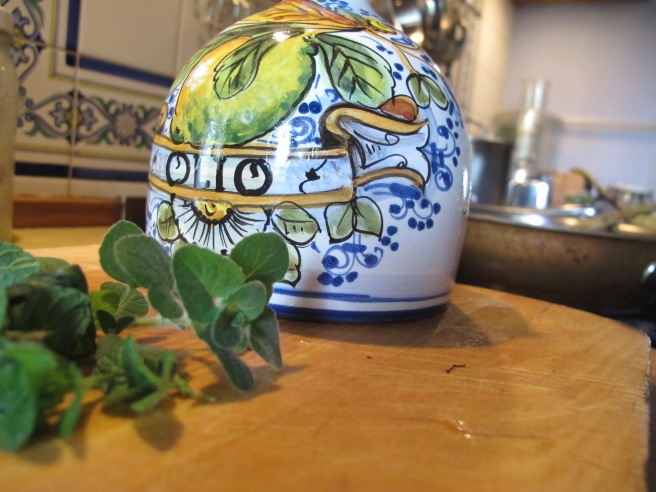 Add the mint and then swirl some more olive oil over the vignarola. It is now ready to be served.
Add the mint and then swirl some more olive oil over the vignarola. It is now ready to be served.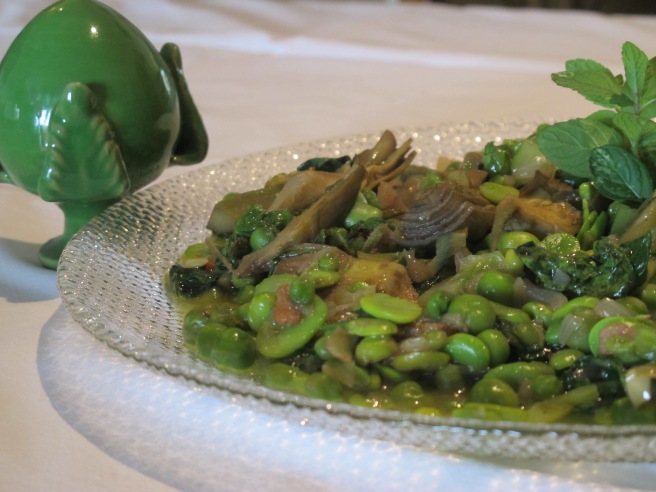
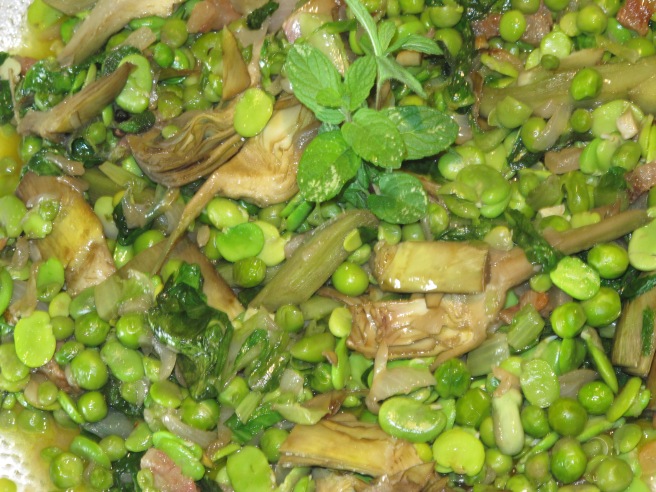
The vignarola is best served at room temperature, not hot. The heat tarnishes the taste somewhat. As with many a stew, vignarola tastes even better the following day.
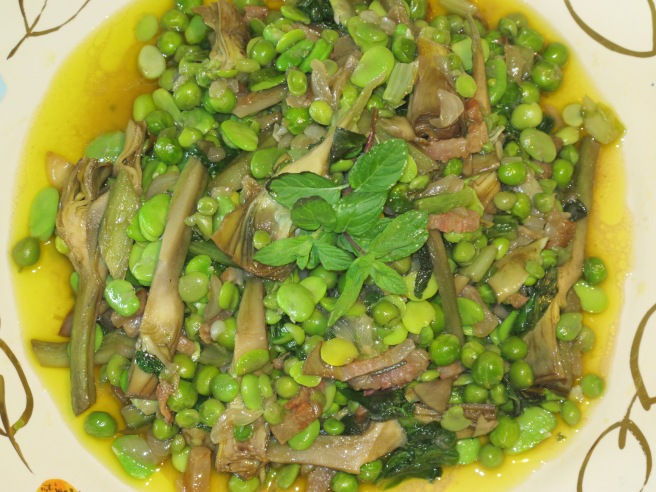 And as you can see, a posh, indeed regal, vignarola … can never be ‘dry’. And don’t forget the bread … to mop up the sauce afterwards.
And as you can see, a posh, indeed regal, vignarola … can never be ‘dry’. And don’t forget the bread … to mop up the sauce afterwards.
The making of a vignarola is a kind of culinary pilgrimage, it must adhere to season and month when these vegetables pop up all together – April. And so one harkens to Chaucer and to his Canterbury Tales and to the ‘pull’ of pilgrimages that this month sparks off. What is tugging at your soul this Spring?
Buona primavera everyone!
Here is the start of the Prologue, in old English, a modern version follows …
1: Whan that aprill with his shoures soote
2: The droghte of march hath perced to the roote,
3: And bathed every veyne in swich licour
4: Of which vertu engendred is the flour;
5: Whan zephirus eek with his sweete breeth
6: Inspired hath in every holt and heeth
7: Tendre croppes, and the yonge sonne
8: Hath in the ram his halve cours yronne,
9: And smale foweles maken melodye,
10: That slepen al the nyght with open ye
11: (so priketh hem nature in hir corages);
12: Thanne longen folk to goon on pilgrimages,
Translation into Modern English:
When April with his showers sweet with fruit
The drought of March has pierced unto the root
And bathed each vein with liquor that has power
To generate therein and sire the flower;
When Zephyr also has, with his sweet breath,
Quickened again, in every holt and heath,
The tender shoots and buds, and the young sun
Into the Ram one half his course has run,
And many little birds make melody
That sleep through all the night with open eye
(So Nature pricks them on to ramp and rage)-
Then do folk long to go on pilgrimage …

